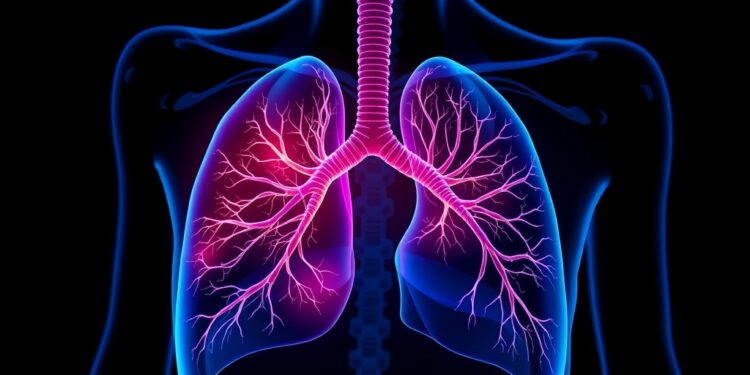Promising Advances in Pulmonary Hypertension Treatment: Exploring the Potential of Pulmonary Artery Denervation
A groundbreaking study recently published in the esteemed International Journal of Cardiology has drawn significant attention within the cardiovascular community. The research focuses on pulmonary artery denervation (PADN), an innovative intervention that offers hope for patients suffering from pulmonary hypertension (PH). As a condition that can lead to debilitating right heart failure and a notably high risk of mortality, PH represents a formidable challenge in modern medicine. Hence, the findings from this meta-analysis offer both promise and insight into potentially transformative approaches to treating this life-threatening condition.
The collaborative effort, led by Dr. James Jenkins, a noted cardiologist from Ochsner Health, analyzed data from a variety of clinical trials dedicated to evaluating the efficacy of PADN. This comprehensive meta-analysis encompassed a total of 14 studies and included a substantial cohort of 372 patients. By carefully dissecting the collected data, the authors aimed to establish a clearer understanding of PADN’s impact on the specific metrics associated with pulmonary hypertension, including hemodynamic parameters and overall clinical outcomes.
The results of this meta-analysis have unveiled a noteworthy potential for PADN to significantly improve key physiological measures in patients suffering from PH. Specifically, the procedure was associated with significant reductions in mean right atrial pressure (mRAP) and mean pulmonary artery pressure (mPAP), along with a decrease in pulmonary vascular resistance (PVR). These improvements are critical, as they directly correlate with better functioning of the cardiovascular system. Furthermore, the procedure appears to enhance cardiac output (CO) and patient performance on the six-minute walk test (6MWT), a widely used measure of exercise capacity and functional mobility in clinical settings.
Despite the encouraging outcomes described in the study, the authors advocate for further research in the form of larger-scale clinical trials. These investigations should be designed to confirm the efficacy of PADN, thoroughly investigate its safety profile, and optimize treatment protocols tailored to individual patients. Furthermore, future studies should delve into the long-term implications of the procedure on overall patient quality of life, given the chronic nature of pulmonary hypertension and its associated challenges.
Dr. Jenkins expressed optimism regarding PADN’s role in the management of pulmonary hypertension, characterizing it as a significant advancement in cardiovascular therapy. He emphasized the need for ongoing research, stating that while the study’s findings underscore a substantial potential for PADN, it is imperative to explore its implications more extensively. This call for continued investigation is essential both to validate the current findings and to uncover new dimensions of how PADN can be effectively integrated into existing treatment protocols for pulmonary hypertension.
The urgency of addressing pulmonary hypertension cannot be overstated. With cardiovascular diseases continuing to rank as one of the leading causes of death worldwide, innovative interventions like PADN represent essential progress in mitigating these life-threatening conditions. The insights gleaned from this research not only underscore the potential of PADN but also illustrate the importance of persistent inquiry in developing effective, evidence-based treatments for ailments that affect millions globally.
In addition to providing a fresh perspective on therapeutic options for pulmonary hypertension, this meta-analysis serves as a testament to the collaborative nature of contemporary medical research. The partnership between experienced clinicians and researchers creates a robust framework for exploring complex medical phenomena and developing interventions that can significantly enhance patient care and outcomes. It is this spirit of cooperation and innovation that will ultimately lead to breakthroughs in the treatment of chronic diseases, including pulmonary hypertension.
Moreover, as the healthcare landscape continues to evolve, the integration of cutting-edge techniques like pulmonary artery denervation invites a broader discussion on the future of cardiac care. How these advancements will be incorporated into standard treatment protocols remains to be seen; however, the urgency of improving the prognosis of high-risk patients necessitates a proactive approach from health systems and practitioners alike.
The pathway toward understanding PADN’s full potential is clear: more extensive clinical trials are required to build upon the findings of this initial meta-analysis. As researchers work to validate the safety and efficacy of this intervention, there is hope that PADN could emerge as a first-line treatment option for pulmonary hypertension in the near future, offering renewed hope to patients and their families navigating the challenges posed by this serious condition.
In conclusion, the investigation into pulmonary artery denervation represents a significant step forward in the cardiology field. It highlights the vital need for ongoing research and innovation in treating complex cardiovascular conditions. As the scientific community rallies around this promising area of study, the potential for groundbreaking shifts in treatment paradigms becomes increasingly tangible. The journey toward optimal management of pulmonary hypertension is ongoing, but with each new study, the landscape grows more hopeful and indicative of progress that could save lives.
Subject of Research:
Innovative Treatment for Pulmonary Hypertension through Pulmonary Artery Denervation
Article Title:
Pulmonary artery denervation in pulmonary hypertension: A comprehensive meta-analysis
News Publication Date:
March 1, 2025
Web References:
International Journal of Cardiology
References:
DOI: 10.1016/j.ijcard.2025.133078
Image Credits:
N/A
Keywords:
Pulmonary hypertension, pulmonary artery denervation, cardiology, clinical trials, cardiovascular disease, right heart failure, hemodynamic assessment, treatment protocols, medical research, patient outcomes.




